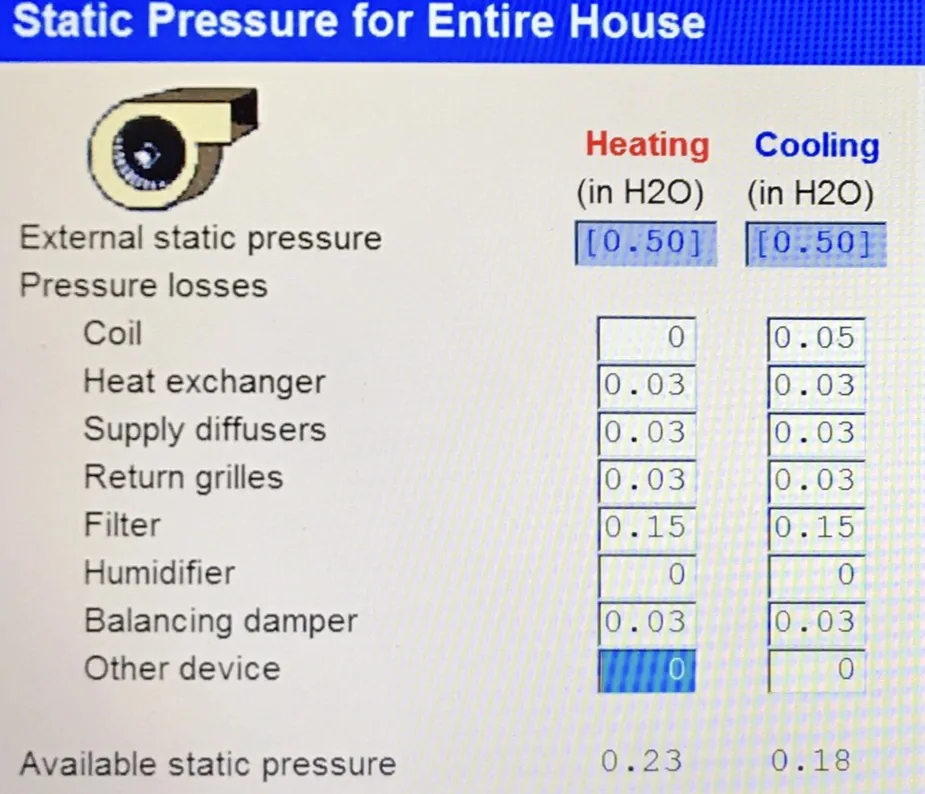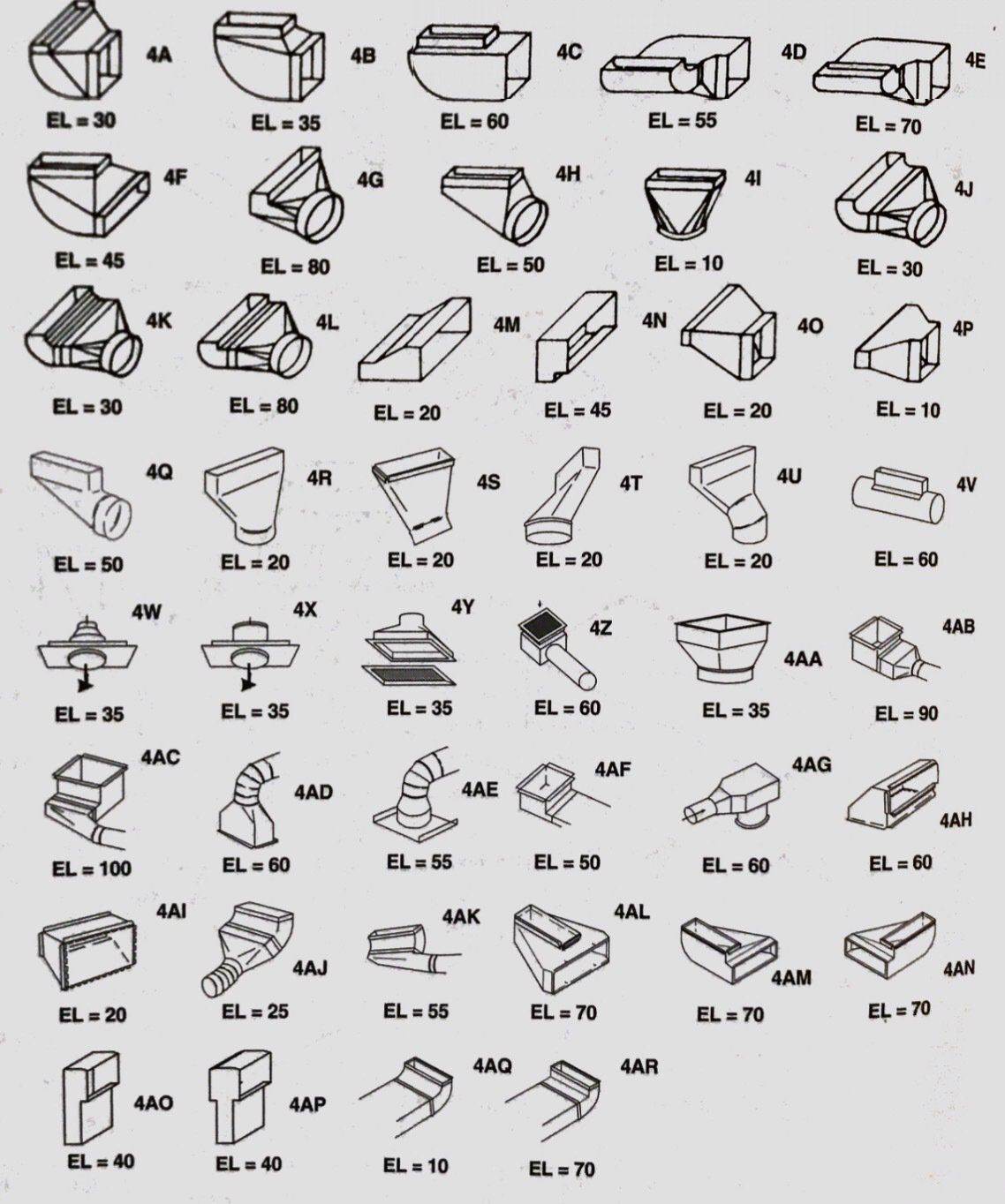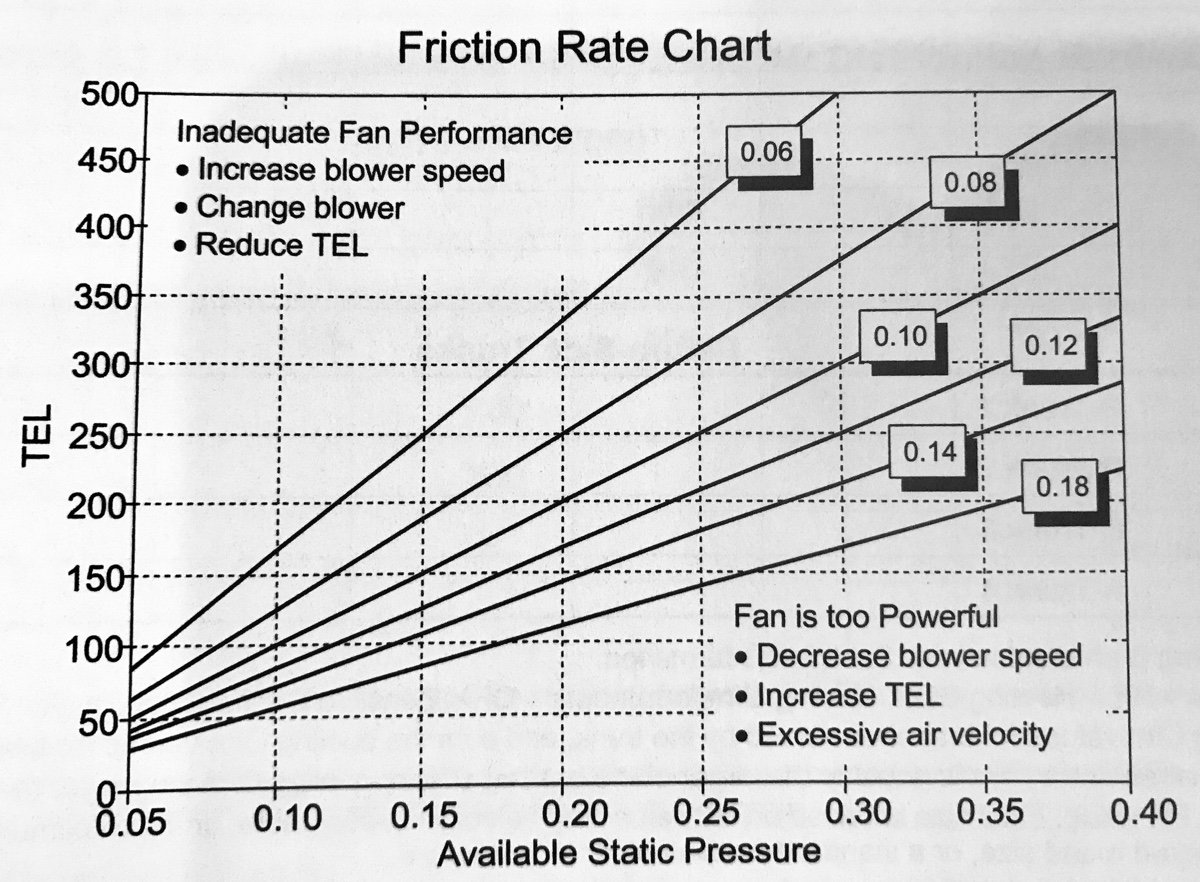Get Tech Tips
Subscribe to free tech tips.
The Friction Rate Chart (and What it Means)

A lot of proper duct design comes down to an understanding of available static pressure and friction rate. We've covered this topic several times on this site and the podcast, but I wanted to focus on this ACCA chart specifically (shown above). If you want a deep dive, I highly recommend listening to my podcast episode with Dr. Allison Bailes.
ASP

The horizontal axis is available static pressure or ASP. It's indicated along the bottom and typically ranges from 0.05 and 0.40.
There is only one way to know your ASP. That is to calculate how much ADDITIONAL static pressure your blower can work against and still provide the correct airflow once everything in the airstream is accounted for. (That would be all things OTHER than the ductwork.)
Coils, filters, dampers, grilles, and heat strips can all fall into that category if they cause a pressure drop. We calculate those static pressure drops in inches of water column at the design airflow.
So, before you can choose an ASP, you need to:
- Look at the manufacturer blower curve or chart.
- Choose a fan speed to achieve design airflow.
- Add up all the other resistances external to the furnace/fan coil.
- Subtract those calculated resistances (frictions) from the rated system operating static pressure (from the fan chart).
This ASP number you come up with can often be adjusted later; you'd do that by choosing a different speed tap on traditional PSC systems or sacrificing efficiency in modern ECM/X13 blowers. Still, to start, we will generally use the 0.50 TESP target as our goal to start with at the rated airflow.
TEL

The vertical axis along the left side displays the total equivalent length (TEL) of the duct in the critical duct path. That is the highest friction path all the way from the return through the supply; it includes the straight duct runs and the equivalent lengths from duct fittings and transitions.
The TEL will always be longer—and generally significantly longer—than the actual lineal length from the longest return to the longest supply.
The Chart

Once you calculate the TEL and ASP, you simply use the chart to figure out where they intersect. That's how you calculate the design friction rate for the duct design.
For example, if we calculated a 300′ equivalent length with an available static pressure of 0.2″WC (which is a very typical situation), that could be interpolated to a design friction rate of 0.07 for the design.
From a practical standpoint, you need to stay within the wedge to have a duct system that will be realistically sized. If you end up above the chart wedge at 0.06, then you need to either find a way to reduce your equivalent length by reducing fittings, moving the furnace to a more central location, using a less restrictive filter, etc. Alternatively, you might need to find some more ASP headroom by choosing a higher blower speed or a more powerful blower that can work against more static pressure.
What if I'm under the wedge?
This next part is MY opinion, but it's backed up by common sense and ACCA Manual D A15-5 (look it up).
If you end up under the wedge, you could POTENTIALLY end up with too much airflow. However, with modern X13/ECM motors, that's pretty unlikely; these motors should ramp down to maintain constant torque/airflow.
Because of that (in most cases nowadays), being under the wedge isn't a real problem. You could still use 0.18 as the design friction rate.
Now, keep in mind that this chart is from ACCA Manual D; it's only designed for residential HVAC. Commercial HVAC is a different process.
—Bryan
P.S. – Neil Comparetto wrote an excellent article about friction rate with a more general scope than this article. If you'd like to check it out, you can read it HERE. Eric Kaiser also covered a lot of bases, including how to use a Ductulator, with his article about friction rate.











Comments
I don’t understand what happens when the friction rate is less than 0.06 IWC. Does air start to cease to move? I see the ACCA wedge and people referencing an minimum of 0.06iwc and a maximum of 0.18iwc. I also see the recommendations if you are below 0.06iwc and above 0.18iwc but I haven’t been able to visualize what is happening outside the ACCA wedge. I guess my question is, why would a friction rate of 0.04iwc not work in the field?
I don’t understand what happens when the friction rate is less than 0.06 IWC. Does air start to cease to move? I see the ACCA wedge and people referencing an minimum of 0.06iwc and a maximum of 0.18iwc. I also see the recommendations if you are below 0.06iwc and above 0.18iwc but I haven’t been able to visualize what is happening outside the ACCA wedge. I guess my question is, why would a friction rate of 0.04iwc not work in the field?
?Elevemos nuestras copas por cada aventurero del riesgo !
https://wikiluck.com.es/review/
– https://wikiluck.com.es/review/
?Que la fortuna te acompane con que vivas grandiosos jackpots memorables !
wikiluck.com.es/review/
?Elevemos nuestras copas por cada aventurero del riesgo !
https://wikiluck.com.es/review/
– https://wikiluck.com.es/review/
?Que la fortuna te acompane con que vivas grandiosos jackpots memorables !
wikiluck.com.es/review/
?Celebremos a cada mito del azar !
wikiluck.com.es/bonus
– http://wikiluck.com.es/bonus/#
?Que la fortuna te sonria con que la suerte te regale intensos beneficios increibles !
wikiluck.com.es
?Celebremos a cada mito del azar !
wikiluck.com.es/bonus
– http://wikiluck.com.es/bonus/#
?Que la fortuna te sonria con que la suerte te regale intensos beneficios increibles !
wikiluck.com.es
Hi Steve, you can design a system at a low friction rate, it’s just not advised. Your ducts will get really big because you just don’t have much of a “budget.” This article may help https://russellking.me/2020/07/05/friction-rate-explained-maybe/
Hi Steve, you can design a system at a low friction rate, it’s just not advised. Your ducts will get really big because you just don’t have much of a “budget.” This article may help https://russellking.me/2020/07/05/friction-rate-explained-maybe/
To leave a comment, you need to log in.
Log In